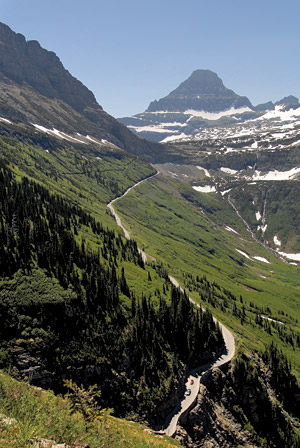As snow returns to the highest peaks of Glacier National Park, the National Park Service and the Federal Highway Administration are finishing up another season of construction on the Going-to-the-Sun Road.
Eighty years after the road was completed, the 52-mile alpine route through the heart of the park is still one of Glacier’s most popular attractions. Since 2006, the road has been the subject of an extensive, multi-year $130 million rehabilitation project. Because of that, the road was opened late and closed early to facilitate work. Long traffic delays have also become common on the road, but Park spokesperson Denise Germann said visitors don’t seem to mind.
“It’s a challenge because of all the traffic we see, but what a great place to be stuck in construction,” Germann said.
This year, contractors focused efforts between Avalanche Creek and Logan Creek and Big Bend and Logan Pass. Project Manager Jack Gordon said parts of the road have been surfaced, repaved and striped. Guardrails were also installed along the route.
Next year, work will continue on the east side and, according to Gordon, construction will begin on the alpine section of the road between Logan Creek and Siyeh Bend. For part of the season, there will be road delays on both the east and west side of the road, until paving work is completed between Avalanche and Logan Creek.
For the first time since construction began, in 2013 the west side won’t close early. That means access to Logan Pass will still be available from West Glacier well into October.
When construction began, Gordon said some people worried the road project would deter visitors from coming to Glacier, but that has not been the case.
“We proved everyone wrong because visitation has only gone up during the construction and with very few complaints,” he said.
According to Germann, at the rate of construction, the entire project should be completed in 2016. The rest of the work is expected to cost another $40 million. Yet even if the major rehabilitation is over, Germann said ongoing maintenance will always be necessary. Such is the case with a road that cuts through the rugged territory of Glacier. Little exemplified that better than the afternoon of July 17.
That day, a fast-moving and intense rainstorm moved over the northern section of the park, dumping an inch and a half of rain in just 30 minutes. During the storm, 12 massive mud and rock slides inundated the roadway just west of Logan Pass, temporarily trapping 150 vehicles. It took workers two days to clear the road.
 |
|
The Going-to-the-Sun Road winds up toward Logan Pass as seen from the High Line Trail in Glacier National Park. File photo by lido Vizzutti | Flathead Beacon |
The incident was recorded by shuttle bus driver Katie Brady and uploaded to YouTube soon after. In the video, a constant stream of rock and water cascade down the mountain.
Gordon said the series of rock slides were very unusual and that the incident set workers back a few weeks, although the damage could have been worse.
“We’ve seen rock slides, we’ve seen debris slides and floods, but never anything that intense in such a localized area,” Gordon said.
As construction work continues next year, Germann said the park would begin working on a corridor management study. The study will specifically look at how the bus shuttle services have been used since construction began. Germann said although the service was first provided as an alternative to driving through the construction, it has become very popular with hikers. Because of that, the park service is considering keeping it after the rehabilitation is completed.
“We want to understand the impact of the shuttle service and what the public and visitors want,” she said.
A few weeks from now the road will again fall silent, as the last construction crew packs up for the season. According to the National Park Service, the earliest the entire route will open in 2013 is June 21. But that date is dependent on weather and plowing conditions next spring.